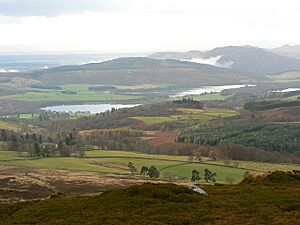Loch of Butterstone facts for kids
Quick facts for kids Loch of Butterstone |
|
|---|---|

Loch of Butterstone in winter
|
|
| Coordinates | 56°35′14″N 3°32′01″W / 56.587100°N 3.533700°W |
| Type | freshwater loch |
| Primary inflows | Lunan Burn |
| Primary outflows | Lunan Burn |
| Surface area | 43.5 ha (107 acres) |
| Average depth | 3.43 m (11.25 ft) |
| Max. depth | 7.6 m (25 ft) |
| Water volume | 1,508,800 m3 (53,283,000 cu ft) |
| Shore length1 | 2.8 km (1.7 mi) |
| Surface elevation | 97 m (318 ft) |
| Max. temperature | 17 °C (63 °F) |
| Min. temperature | 12 °C (53 °F) |
| Settlements | Dunkeld |
| 1 Shore length is not a well-defined measure. | |
The Loch of Butterstone is a small, nearly round freshwater lake. It is located in a nature reserve called the Cardney Estate. This beautiful loch is found near the town of Dunkeld in Perth and Kinross, Scotland.
It is one of three lakes that are close to each other. The other two are Loch of the Lowes and Loch of Craiglush. These three lochs form a group known as the Lunan Lochs. Loch of Butterstone is at the northwest end of this group.
Contents
About the Loch of Butterstone
Loch of Butterstone is known for its incredibly clear water. People often describe it as gin clear. This is quite special in Scotland, as many lochs have a darker, peaty color. The loch is a popular spot for fly fishing.
Location and Nearby Towns
The largest town close to the loch is Dunkeld. It lies to the southeast of the lake. A main road, the A923, passes to the north of the three Lunan Lochs. This road connects Dundee to Dunkeld.
The Lunan Burn
The loch is at the start of a valley where the Lunan Burn flows. This burn (which is a small stream or river) flows east and southeast. It eventually joins the River Isla near Coupar Angus.
Surrounding Landscape
The three Lunan Lochs are in a shallow valley. Looking from Dunkeld, the valley faces northeast. A notable feature nearby is Newtyle Hill, which is about 317 meters (1,040 feet) high. It is closest to Loch of Lowes.
On the other side of the valley are some smaller hills. These include Crieff Hill, which rises to Craig More. The area around the loch is very wooded. For example, Drumbuie Wood is on the west slope, if you are looking from Dunkeld.
Conservation and Nature
The Loch of Butterstone is part of the Cardney Estate nature reserve. This means the area is protected to help preserve its natural beauty and wildlife. It is also recognized as a Site of Special Scientific Interest and a Special Area of Conservation. These titles show how important the loch and its surroundings are for nature.
Many people enjoy birdwatching here. The area is home to various birds and other wildlife. Protecting these areas helps animals and plants thrive.



